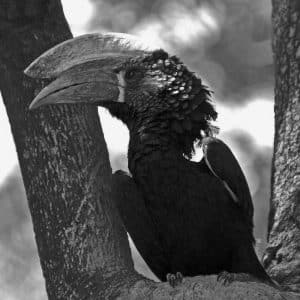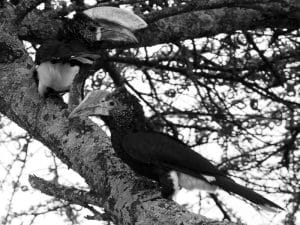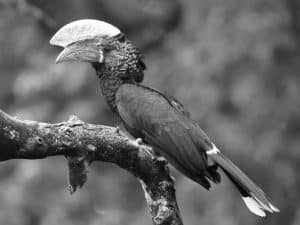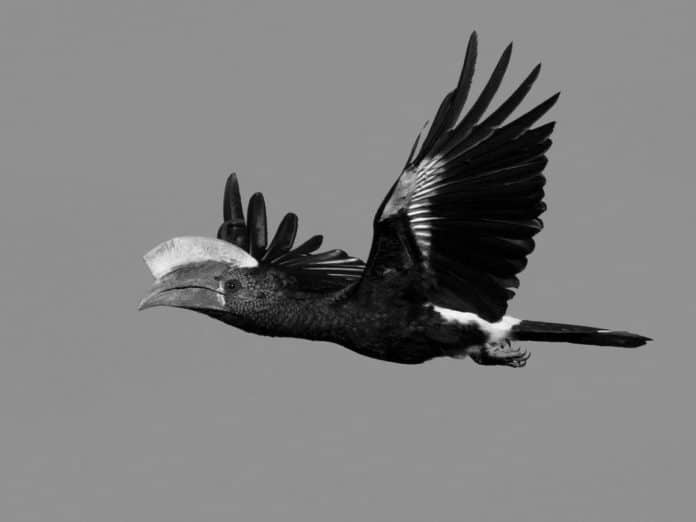Introduction to the Silvery-Cheeked Hornbill
Welcome to the enchanting world of the Silvery-Cheeked Hornbill, a majestic bird species that graces the lush rainforests of Tanzania with its ethereal presence. Scientifically known as Bycanistes brevis, this stunning avian creature is renowned for its striking appearance and unique behaviors, captivating the hearts of bird enthusiasts and nature lovers around the globe. With its distinct features and vital role in the ecosystem, the Silvery-Cheeked Hornbill in Tanzania holds a special place in the biodiversity of Tanzania, making it a fascinating subject of study and admiration.

Native to the eastern region of Africa, the Silvery-Cheeked Hornbill is predominantly found in the verdant landscapes of Tanzania, where it thrives in the canopies of dense rainforests. As a symbol of natural beauty and ecological significance, this remarkable bird has become an emblem of conservation efforts and wildlife preservation in the country, drawing attention to the delicate balance of the ecosystem and the importance of safeguarding its rich biodiversity. In this comprehensive guide, we will delve into the mesmerizing world of the Silvery-Cheeked Hornbill, exploring its habitat, behavior, conservation status, and the crucial role it plays in the captivating Tanzanian rainforests.
Habitat and Distribution of the Silvery-Cheeked Hornbill in Tanzania
The Silvery-Cheeked Hornbill is an iconic inhabitant of the magnificent rainforests that adorn the landscapes of Tanzania, where it finds sanctuary amidst the lush greenery and abundant biodiversity. These captivating birds are primarily found in the coastal and montane forests of eastern Tanzania, including the Usambara and Uluguru Mountains, as well as the Eastern Arc Mountains. With their preference for dense, primary forests, the Silvery-Cheeked Hornbills thrive in the upper canopy layers, where they can forage, breed, and seek refuge within the intricate network of branches and foliage.
The unique distribution of the Silvery-Cheeked Hornbill within Tanzania reflects the diverse range of habitats that the country offers, encompassing both lowland and highland rainforests. From the coastal plains to the mountainous terrains, these elegant birds have adapted to a variety of ecosystems, demonstrating their resilience and adaptability in the face of environmental changes. However, the conservation of these vital habitats is crucial to ensuring the continued presence of the Silvery-Cheeked Hornbill in Tanzania, as the destruction of forests poses a significant threat to their survival.
Physical Characteristics and Behavior of the Silvery-Cheeked Hornbill
The Silvery-Cheeked Hornbill is a sight to behold, with its striking appearance and graceful demeanor captivating the imagination of bird enthusiasts and researchers alike. Adorned with a glistening black plumage, the male Silvery-Cheeked Hornbill boasts a resplendent silver-white patch on its cheeks, a distinctive feature that lends the bird its name and sets it apart as a symbol of elegance and beauty in the avian world. With its large, curved bill and prominent casque atop its head, the Silvery-Cheeked Hornbill exudes a regal aura, commanding attention and admiration wherever it is found.
In addition to its remarkable physical attributes, the Silvery-Cheeked Hornbill is known for its fascinating behaviors, including its unique nesting habits and vocalizations. These birds are cavity nesters, utilizing natural tree hollows or abandoned nest sites created by other animals to rear their young and seek shelter. The female seals herself inside the nest during the incubation period, relying on the male to provide food and protection until the chicks are ready to fledge. Furthermore, the melodious calls of the Silvery-Cheeked Hornbill echo through the rainforest canopy, serving as a distinctive soundtrack to the vibrant ecosystems in which they reside.
Conservation Status and Threats
Despite its intrinsic value and ecological significance, the Silvery-Cheeked Hornbill faces a range of threats that jeopardize its survival in the wild. The International Union for Conservation of Nature (IUCN) has classified the species as Near Threatened, highlighting the pressing need for concerted conservation efforts to mitigate the risks and challenges that confront these magnificent birds. Habitat loss and fragmentation due to deforestation, agricultural expansion, and human encroachment pose significant threats to the Silvery-Cheeked Hornbill, diminishing the availability of suitable nesting sites and foraging grounds essential for their sustenance and reproduction.
In addition to habitat degradation, the illegal wildlife trade and hunting of hornbills for their casques and body parts have emerged as major concerns, driven by the demand for traditional medicine and cultural artifacts. The exploitation of these birds for commercial purposes has led to a decline in their populations, placing them at risk of local extirpation and further endangering their status in the wild. Addressing these complex challenges requires a multi-faceted approach that encompasses habitat protection, law enforcement, community engagement, and sustainable resource management to safeguard the future of the Silvery-Cheeked Hornbill in Tanzania.
The Role of Silvery-Cheeked Hornbills in Tanzanian Rainforests

The Silvery-Cheeked Hornbill plays a pivotal role in the intricate web of life that characterizes the Tanzanian rainforests, contributing to the health and resilience of these biodiverse ecosystems. As frugivorous birds, they are essential seed dispersers, consuming a variety of fruits and berries from the forest canopy and dispersing the seeds across different locations as they forage and travel. This process of seed dispersal facilitates the regeneration of plant species and contributes to the maintenance of forest diversity, shaping the dynamics of vegetation and promoting the sustainability of the ecosystem.
Furthermore, the presence of Silvery-Cheeked Hornbills influences the composition of plant communities and the abundance of certain tree species, exerting a positive impact on the structure and dynamics of the rainforest. By selectively feeding on fruits and engaging in territorial behaviors, these birds contribute to the maintenance of ecological balance and the perpetuation of plant populations, underscoring their significance as keystone species within their natural habitats. Their interactions with the environment exemplify the intricate connections that underpin the functioning of ecosystems and highlight the irreplaceable role of the Silvery-Cheeked Hornbill in sustaining the biodiversity of Tanzanian rainforests.
Best Places for Birdwatching and Spotting Silvery-Cheeked Hornbills in Tanzania
If you are an avid birdwatcher or wildlife enthusiast seeking to catch a glimpse of the magnificent Silvery-Cheeked Hornbill in its natural habitat, Tanzania offers a host of prime locations for unforgettable birdwatching experiences. The lush rainforests and protected areas of eastern Tanzania, including the Udzungwa Mountains National Park, the Kilombero Nature Reserve, and the Nguu Mountains, provide ideal settings for encountering these iconic birds amidst the splendor of their verdant surroundings. Additionally, the Amani Nature Reserve and the Pugu Hills Forest Reserve offer opportunities to observe the Silvery-Cheeked Hornbill in its native environment, along with a myriad of other avian and wildlife species that inhabit these remarkable landscapes.
For those seeking a more immersive experience, guided birdwatching tours and ecotourism initiatives in collaboration with local conservation organizations offer the chance to explore the captivating rainforests of Tanzania and witness the beauty of the Silvery-Cheeked Hornbill up close. These excursions not only provide unparalleled opportunities for birdwatching and wildlife photography but also contribute to the support of conservation efforts and the sustainable management of natural resources. By participating in responsible ecotourism activities, visitors can make a positive impact on the preservation of Silvery-Cheeked Hornbill habitats and contribute to the long-term conservation of Tanzania’s rich biodiversity.
Conservation Efforts and Organizations Supporting Silvery-Cheeked Hornbill Protection
In response to the escalating threats facing the Silvery-Cheeked Hornbill, a number of conservation organizations and initiatives have emerged to champion the protection and preservation of these iconic birds and their habitats in Tanzania. The Wildlife Conservation Society (WCS), in collaboration with local partners and government agencies, has been actively involved in research, advocacy, and field conservation programs aimed at safeguarding the Silvery-Cheeked Hornbill and promoting sustainable forest management practices. Through the establishment of protected areas, community-based conservation projects, and capacity-building initiatives, these organizations are working to address the root causes of habitat destruction and wildlife exploitation, fostering a harmonious coexistence between humans and nature.
Furthermore, the engagement of local communities and indigenous groups in conservation efforts has proven instrumental in promoting the conservation of the Silvery-Cheeked Hornbill and fostering a sense of stewardship towards the natural environment. By involving community members in habitat restoration, sustainable livelihood programs, and environmental education initiatives, conservation organizations are empowering local stakeholders to become guardians of the rainforests and advocates for the protection of their ecological heritage. These collaborative endeavors underscore the importance of inclusive conservation approaches that recognize the intrinsic link between human well-being and the preservation of biodiversity, emphasizing the shared responsibility of all individuals in safeguarding the future of the Silvery-Cheeked Hornbill and its habitats.
The Importance of Ecotourism in Preserving Silvery-Cheeked Hornbill Habitats
Ecotourism plays a pivotal role in promoting the conservation of the Silvery-Cheeked Hornbill and its habitats in Tanzania, offering a sustainable avenue for raising awareness, generating economic support, and fostering a deeper appreciation for the natural wonders of the country. By attracting visitors from around the world to experience the splendor of Tanzanian rainforests and the captivating biodiversity they harbor, ecotourism initiatives create opportunities for local communities to derive livelihoods from the responsible utilization of natural resources and the provision of ecologically sensitive tourism services.
The revenue generated from ecotourism activities contributes to the maintenance and management of protected areas, the implementation of conservation projects, and the support of local conservation organizations, thereby creating a direct link between the economic benefits of tourism and the preservation of the Silvery-Cheeked Hornbill and its fragile ecosystems. Moreover, ecotourism fosters a sense of environmental stewardship among visitors, encouraging them to engage in sustainable travel practices, support ethical wildlife encounters, and contribute to the conservation of natural habitats through their participation in ecologically conscious tourism activities.
Tips for Responsible Birdwatching and Wildlife Photography in Tanzania

As you embark on your journey to witness the splendor of the Silvery-Cheeked Hornbill and the captivating wildlife of Tanzania, it is essential to prioritize responsible birdwatching and wildlife photography practices that minimize disturbance to the natural environment and uphold ethical standards of engagement with the local fauna and flora. By adhering to the following guidelines, you can ensure that your interactions with the Silvery-Cheeked Hornbill and other wildlife species are respectful, sustainable, and contribute to the conservation of their habitats:
- Respect Wildlife Distances: When observing the Silvery-Cheeked Hornbill and other birds, maintain a respectful distance that allows them to behave naturally without feeling threatened or disrupted by human presence. Use binoculars or telephoto lenses to appreciate their beauty from afar, avoiding the temptation to approach too closely for the sake of photography.
- Minimize Noise and Intrusion: While in the vicinity of wildlife, minimize noise levels and sudden movements to avoid causing unnecessary stress or disturbance to the animals. Respect their space and behavioral cues, allowing them to carry out their natural activities without feeling encroached upon.
- Follow Established Trails and Guidelines: When exploring rainforest environments, adhere to designated trails and follow the guidelines provided by park authorities and local guides. This helps prevent habitat degradation and minimizes the impact of human presence on sensitive ecosystems.
- Support Local Conservation Initiatives: Contribute to the preservation of Silvery-Cheeked Hornbill habitats by supporting local conservation organizations, ecotourism ventures, and sustainable community projects that promote the protection of wildlife and natural landscapes.
By embracing these principles of responsible birdwatching and wildlife photography, you can partake in meaningful experiences that honor the intrinsic value of the Silvery-Cheeked Hornbill and its role in the conservation of Tanzanian rainforests.
Conclusion
In the midst of the ancient Tanzanian rainforests, the Silvery-Cheeked Hornbill stands as a symbol of resilience, beauty, and ecological interconnectedness, weaving its elegant presence into the fabric of the verdant landscapes and captivating the hearts of all who behold its grace. As we reflect on the significance of these majestic birds and the vital role they play in sustaining the biodiversity of Tanzania, we are reminded of the profound importance of conservation, community engagement, and responsible tourism in preserving the natural wonders that enrich our world.
By embracing the splendor of the Silvery-Cheeked Hornbill and supporting the ongoing efforts to protect its habitats, we contribute to the legacy of conservation and environmental stewardship, safeguarding the future of these remarkable birds and the irreplaceable rainforests they call home. Let us cherish the silvery elegance that graces the Tanzanian rainforests, and may our collective dedication to their preservation serve as a testament to the enduring harmony between humanity and the natural world.

































